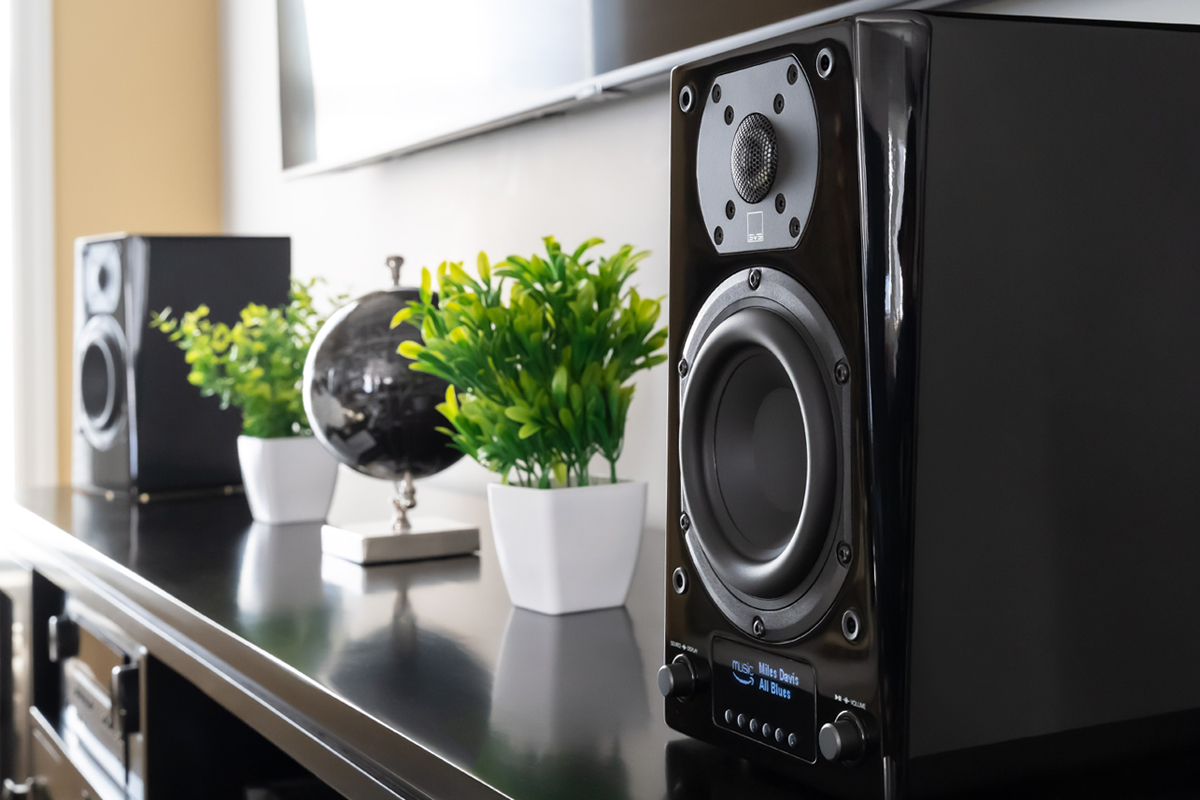 Quite often, when a manufacturer updates a popular product, the new model offers only incremental improvements over the one it replaces. But sometimes, the new product represents a major upgrade over the original; and that is the case with SVS’s Prime Wireless Pro active loudspeaker system ($899.99, all prices in USD). The Prime Wireless Pro costs 50% more than the company’s Prime Wireless active speaker system (discontinued, $599.99 when available), but it contains a host of improvements.
Quite often, when a manufacturer updates a popular product, the new model offers only incremental improvements over the one it replaces. But sometimes, the new product represents a major upgrade over the original; and that is the case with SVS’s Prime Wireless Pro active loudspeaker system ($899.99, all prices in USD). The Prime Wireless Pro costs 50% more than the company’s Prime Wireless active speaker system (discontinued, $599.99 when available), but it contains a host of improvements.
Like its predecessor, the Prime Wireless Pro is a two-way, rear-ported active design, with a 50W class-D amp for each driver. Both models employ a 1″ aluminum-dome tweeter. But it’s paired with a 5.25″ polypropylene midrange-woofer in the Prime Pro, rather than the 4.5″ driver of the original Prime Wireless. Along with the Prime Pro’s bigger enclosure and “fully rebuilt” DSP engine, the larger driver delivers greater bass extension and improved dynamics, according to Smith Freeman, SVS’s senior director of product management, whom I spoke with on a Zoom call in late August. Specified frequency response is 42Hz–25kHz, ±3dB, compared with 52Hz–25kHz, ±3dB, for the original Prime Wireless.
Unlike the first-generation Prime, the Prime Wireless Pro has an HDMI port with ARC and eARC support. This enables the Prime Pro to play two-channel PCM audio from a connected HDTV, and to control volume with the TV remote. The OLED display on the Prime Pro’s primary speaker shows track metadata, volume level, and selected input—this information isn’t shown on the original model’s display. The Prime Pro also comes with an infrared remote control, which was absent from the earlier model.
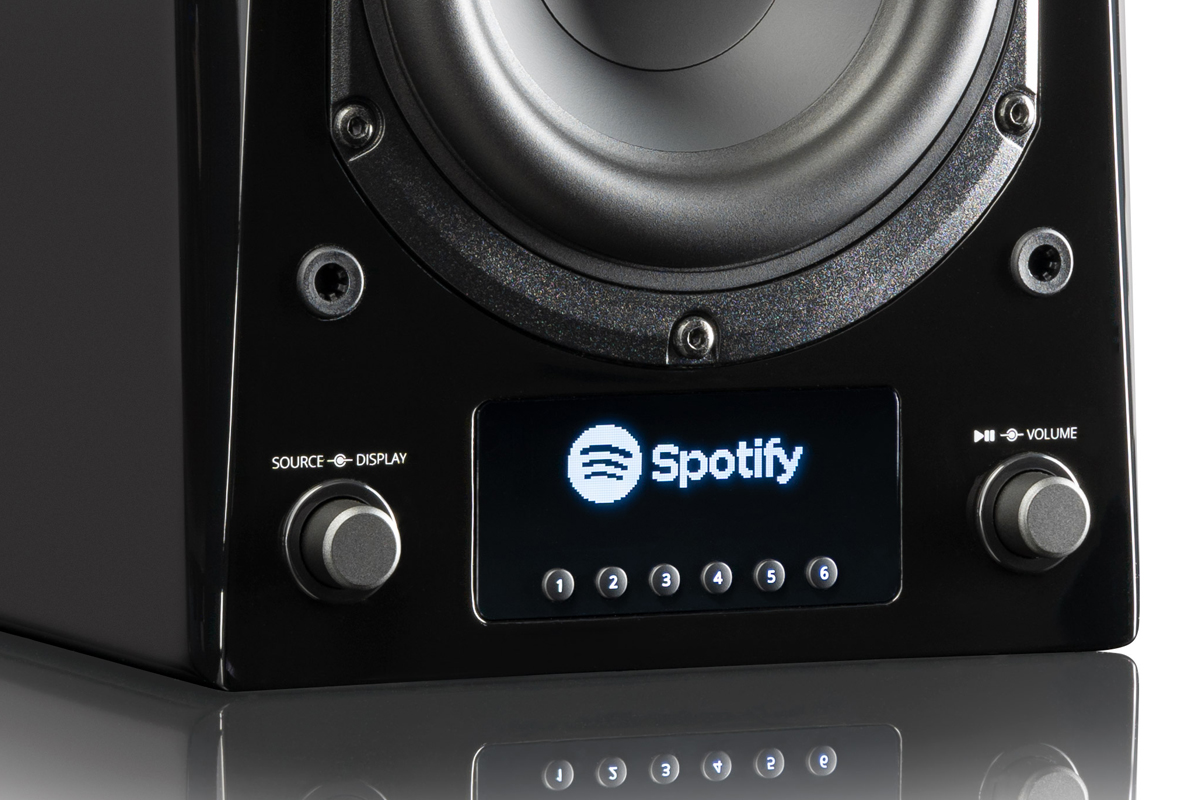
At the bottom of the Prime Pro’s display are six pushbuttons that give instant access to favorite internet radio stations and playlists. On the original Prime, you could toggle through the presets by pushing the knob to the left of the display. But you had to program those presets in the Play-Fi app that controls the system. As you’ll read later, presets are much easier to program on the Prime Pro.
Speaking of the Play-Fi app, the Prime Wireless Pro benefits from some major software improvements. DTS’s Play-Fi multiroom music platform has a lot going for it, notably its broad support by multiple brands. This lets you assemble a whole-home music system using components from different manufacturers. But some fundamental limitations have led a few licensees to abandon the Play-Fi platform.
Chief among these limitations has been Play-Fi’s lack of support for gapless playback, which was my main criticism of the Prime Wireless when I reviewed it in March 2019. That problem has now been fixed. In early October, while I was working on this review, DTS released new Play-Fi firmware that adds gapless playback support.
The Prime Wireless Pro has more options for listeners who would rather not use Play-Fi. In addition to Bluetooth connectivity and Spotify Connect support, the Prime Pro offers Apple AirPlay 2 and Google Chromecast capability.
Inside and out
Something that hasn’t changed is the build quality, which is superb. Like its predecessor, the Prime Wireless Pro is available in high-gloss black and high-gloss white finishes and comes with color-matched cloth grilles that attach to the baffles with peg inserts. The front baffles have chamfered edges that slant inward toward the top of the cabinet for a retro late-1990s look. The fit and finish of my high-gloss black version was impeccable.
The Prime Wireless Pro is an active system, with separate amplifiers for the midrange-woofers and tweeters, and a DSP-based crossover that comes before the amplifiers in the signal path. In addition to implementing the 2kHz second-order crossover, the DSP in the primary speaker performs dynamic EQ to protect the drivers when the speakers are playing bass-heavy content at high volumes.
The electronics and the inputs and outputs are housed in the right (primary) speaker. Channel allocation cannot be changed, which could be an issue for listeners who want to connect source components that are located near the left speaker.
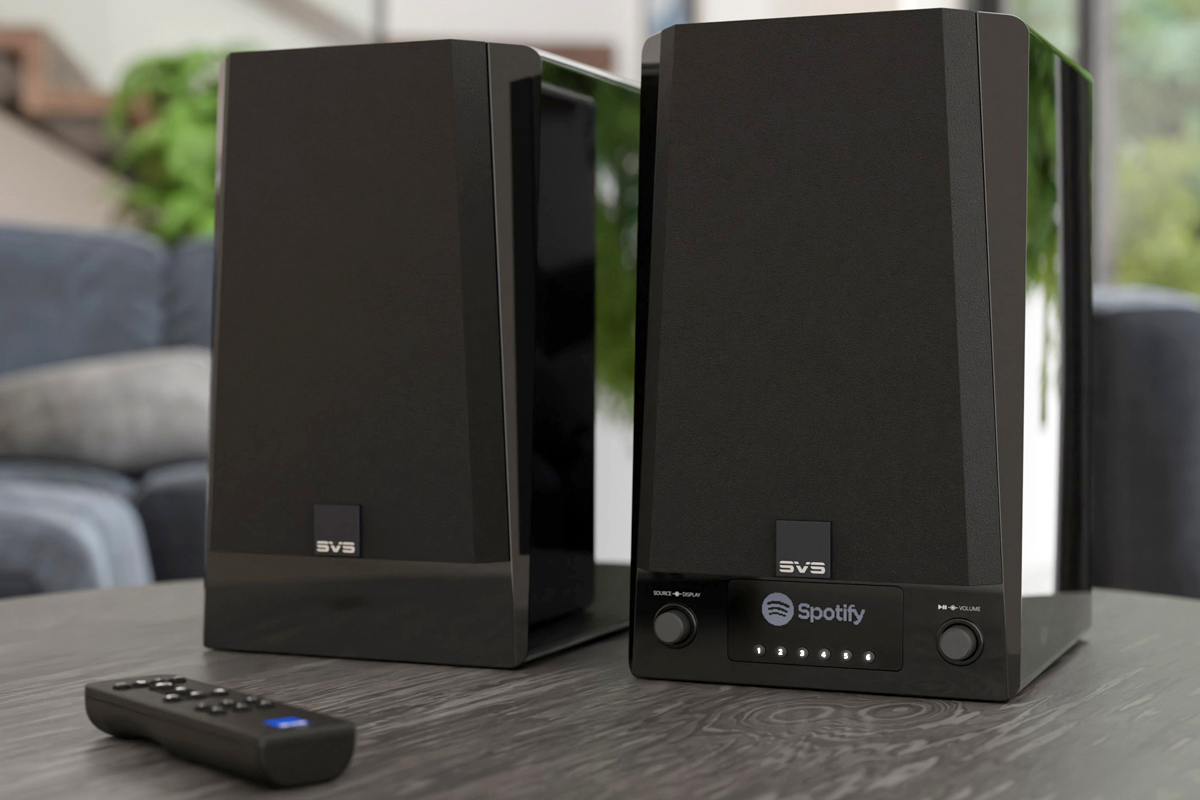
Speaker-level audio is sent from the right to the left (secondary) speaker via a four-conductor cable, terminated in proprietary connectors, that carries separate signals for the midrange-woofer and tweeter. The 10′ cable supplied with the system is long enough for most desktop or bookshelf installations. SVS offers 15′ and 20′ cables as a special-order option.
The secondary speaker just has a bass port and the connector for the proprietary speaker cable on the back. The primary speaker has an ethernet input and output, RCA and 3.5mm analog inputs, an optical S/PDIF (TosLink) input, an HDMI port with ARC and eARC support, a subwoofer output, and the proprietary connector for sending audio to the left speaker. Maximum resolution is 24-bit/96kHz via TosLink and 24/192 via ethernet and Wi-Fi.
The subwoofer output is not low-pass-filtered; you have to enable a low-pass filter on the subwoofer. However, when a sub is connected, the Prime Wireless Pro’s DSP implements an 80Hz high-pass filter for the main speakers so that they don’t have to reproduce deep bass. This typically translates to greater clarity in the mid- and upper bass, as well as improved dynamics.
Each enclosure measures 11.5″H × 7″W × 9″D. The primary speaker weighs 12.3 pounds and the secondary speaker weighs 11.7 pounds. The grilles cover all but the bottom 2″ of the front baffle. On the right speaker, this area is occupied by a control panel with rotary knobs on either side, and in the middle, a 3″ OLED display that shows track metadata, volume, and selected source. Push the knob on the left to turn the display on and off; rotate it to cycle through sources. Push the knob on the right to pause and resume playback, rotate it to adjust volume. Below the screen are six illuminated pushbuttons that function like car-radio presets. You can program any button to play a favorite internet radio station or playlist by pressing and holding it while the desired content is playing. Nice and simple.
The supplied plastic remote has the usual buttons for selecting and controlling playback, as well as for muting and adjusting display brightness (or turning it off entirely), and selecting presets.
Setup and software
The guide packaged with the Prime Wireless Pro has all the information most users will need to set up the system and use it on a day-to-day basis. A detailed manual that includes a lot of advice on using Play-Fi can be downloaded from SVS’s online document library.
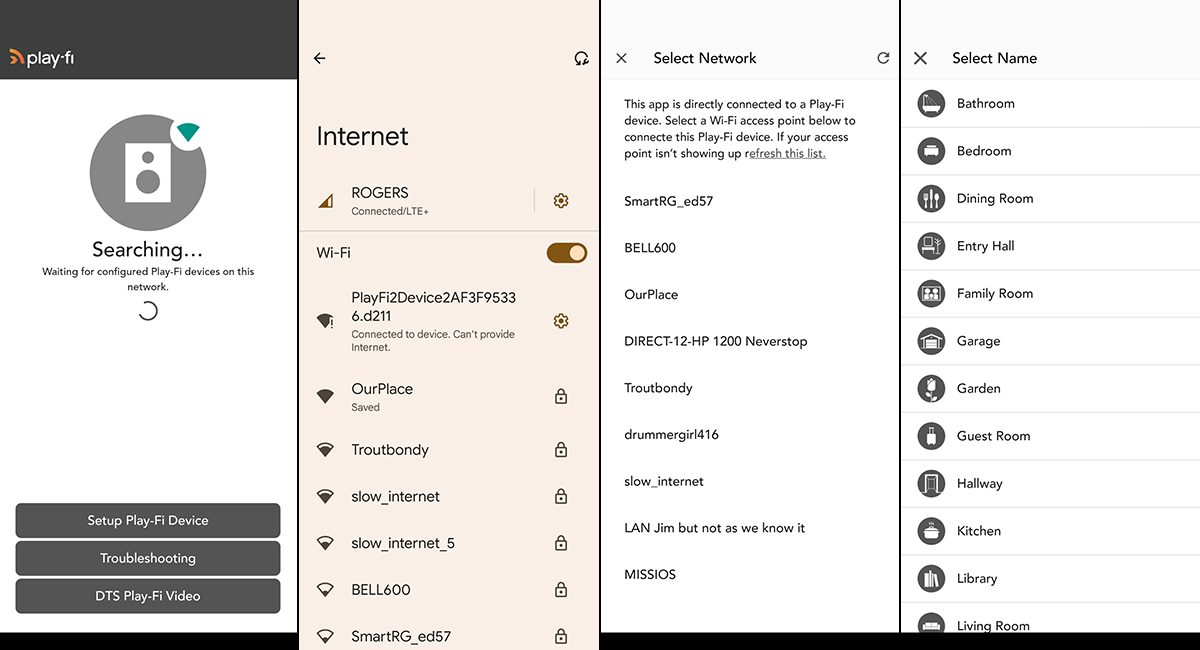
Per the quick start guide, I downloaded and launched the Play-Fi app on my Google Pixel 4a smartphone, then selected Setup Play-Fi Device in the opening menu. After presenting a tutorial, the app prompted me to connect my phone to the Play-Fi hotspot network in order to set up the Prime Pro on my home Wi-Fi network. That done, I was prompted to name the speaker system, and then to configure Chromecast and Google Assistant.
The Prime Wireless Pro had already been found in the Google Home app, so all I had to do was assign it to a room, and then I was able to send audio to the speakers from any Cast-enabled app. It also appeared as an AirPlay 2 device, so that I could stream audio from any app on my iPhone 8 or MacBook Pro. So far, so good.
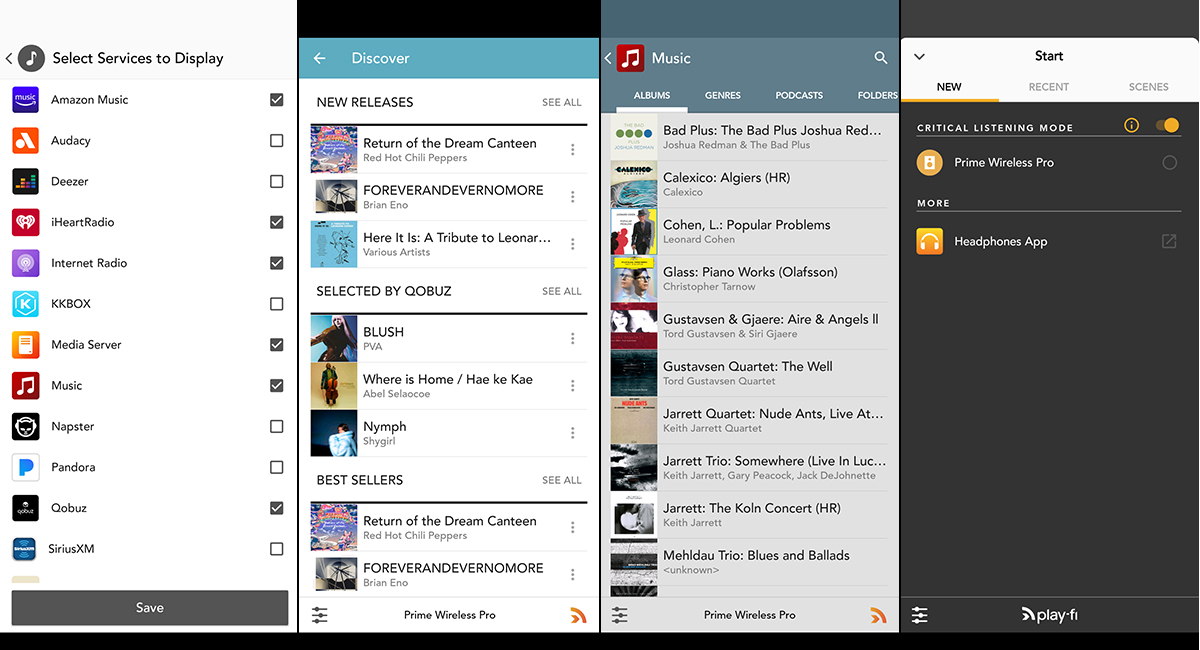
Play-Fi lets you play files stored on your smart device, or from a dozen or so streaming services, including some that support lossless and hi-rez audio, such as Amazon Music, Deezer, Qobuz, and Tidal. In the Settings menu, you can select the services that you want to see on the app’s home screen.
I have never been completely comfortable with the Play-Fi app. I sometimes need to blunder about to make the app do what I want. For example, it took some poking around for me to figure out how to enable Critical Listening Mode so that I could listen in hi-rez. (There’s a little slide control for this function on Play-Fi’s start screen.) If you select Critical Listening Mode, you can only play audio in a single Play-Fi zone, so it has to be turned off if you want to play music in more than one zone at the same time. If you want to stream in hi-rez from a service like Qobuz in the Play-Fi app, you’ll also have to change the streaming quality for that service in Play-Fi. Play-Fi’s default setting for Qobuz is 320kbps MP3.
After I had dialed in the settings I wanted, Play-Fi worked well for me in day-to-day use. Maybe DTS has improved the app, or maybe I’ve become more used to it. As noted, you can also stream to the Prime Wireless Pro via Chromecast, AirPlay 2, or Spotify Connect. So, after setup, you may not have to use the Play-Fi app at all.
During my testing, streaming from the Play-Fi app worked flawlessly; I never experienced any hiccups. Ditto for AirPlay 2. With Chromecast, I experienced frequent stuttering when streaming 24/96 tracks from Qobuz, although stuttering was less frequent and shorter in duration with CD-resolution music. One other note: while Play-Fi and AirPlay 2 support gapless playback, Chromecast does not. In my testing of the Prime Pro, Chromecast inserted a gap of about five seconds between each track.
I didn’t try Amazon Alexa or Google Assistant voice control as I don’t find this feature very useful for music playback.
Listening
For my first round of listening, I placed the Prime Wireless Pro speakers on IsoAcoustics ISO-130 stands on the top shelf of the secretary desk in my home office. The speakers were 3′ apart and 4′ from my listening position as I leaned back in my office chair. Their back panels were 5″ from the wall behind them.
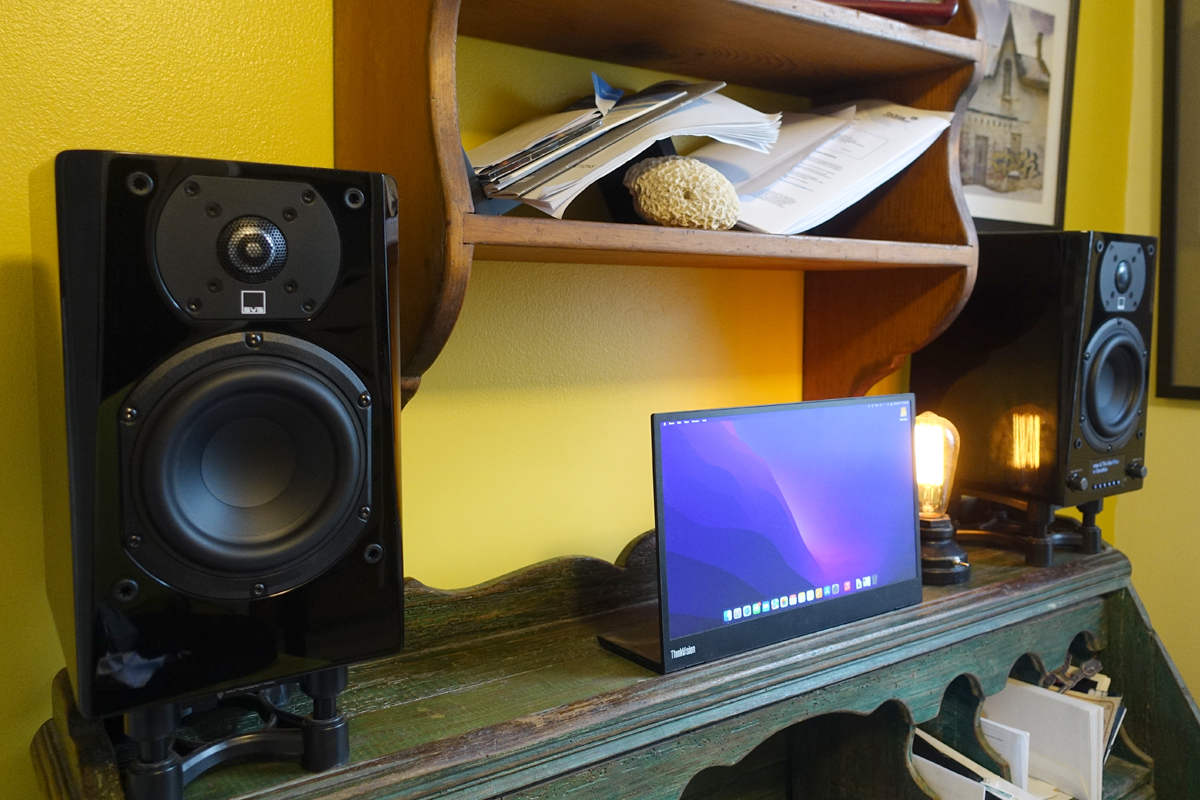
For desktop listening, I appreciated the front-panel controls on the right speaker. The preset buttons made it easy to cue up my favorite internet radio stations when I wasn’t doing focused work, and the volume and play/pause controls made it easy to turn the music down when I needed to concentrate. Another useful feature, which you can enable in Play-Fi’s Advanced Settings menu: if you’re streaming music from the Play-Fi app on your phone, the app will automatically pause playback when you’re placing or receiving a call, then resume playback when the call ends.
I started by streaming “Silence Is the Question,” the final track on The Bad Plus Joshua Redman (24-bit/96kHz ALAC, Nonesuch), from the Play-Fi app on my Google Pixel smartphone. On this album, saxophonist Joshua Redman joins the high-energy jazz trio The Bad Plus in its original incarnation, with pianist Ethan Iverson, double-bassist Reid Anderson, and drummer Dave King.
The quiet double-bass solo that opens the track sounded delectable through the Prime Wireless Pro. Anderson’s gentle plucks were very well defined and segued naturally into the woody resonance of the instrument’s soundbox. While the sound of the double bass was a bit boomy because of the speakers’ proximity to the front wall, that boom was not at all bothersome. Still, it would have been nice if the Prime Pro had DSP-enabled boundary compensation to address this usage scenario, which I’m sure is common for speakers of this type.
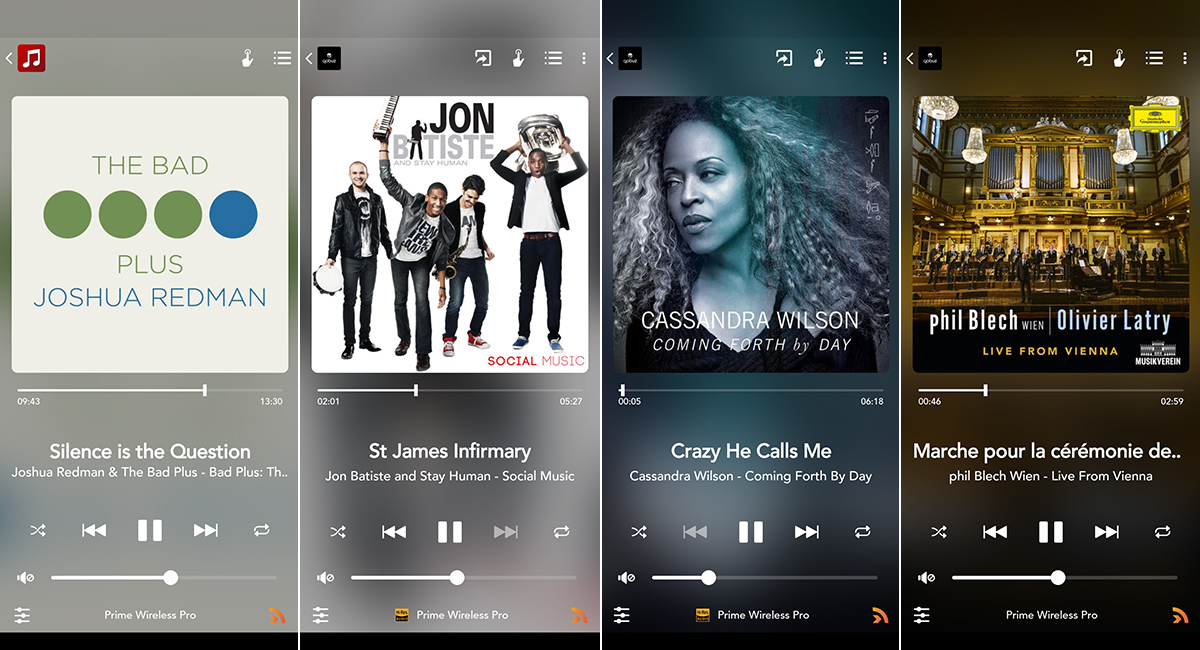
The tone of Iverson’s piano was robust and full-bodied, and not at all clangy, with beautiful, ringing clarity in the upper octaves. Microdynamics were excellent; the Prime Pro articulated Iverson’s gentle rolled chords beautifully. Similarly, the SVS system brought out Redman’s expressive dynamic shifts on alto sax. As the music became more intense, I loved the way the SVS system tracked Redman’s rapid phrasing. The tone of his instrument was spot-on. Redman’s squawks and toots were dramatic, but never ugly or grating. King’s rapid cymbal beats at the beginning of the track had lovely metallic shimmer, and his big strokes on the snare and floor tom later in the song had impressive impact.
During the chaotic wall-of-sound passages in the middle of the track, the Prime Pro did an admirable job separating the various elements: Iverson’s thunderous chords and phrases, King’s feral drumming, Anderson’s rapid-fire runs, and Redman’s wild improvising. During the wildest moments, the sound became a little thick and congested, but never harsh or distressed. This track is a torture test, and the SVS system acquitted itself very well, especially considering it was delivering peaks at over 85dB.
The Prime Wireless Pro was just as impressive with a hard-hitting rendition of “St. James Infirmary” by Jon Batiste and Stay Human, from their album Social Music (16/44.1 FLAC, Razor & Tie / Qobuz). It starts quietly, with Batiste tinkling a little piano riff on the left and Ibanda Ruhumbika playing mournful phrases on bass tuba on the right, after which Batiste begins singing the first verse. The timbres of the piano, tuba, and Batiste’s voice were very convincing.
Then things ramp up quickly, with Joe Saylor drumming ferociously, Eddie Barbash wailing on alto sax, and Batiste adding thunderous chords and runs. I admired the way these little speakers kept their composure in this dense, frenetic passage. While the sound became a little dense, it was never harsh or strident. Another torture test, and another excellent performance by the Prime Pro.
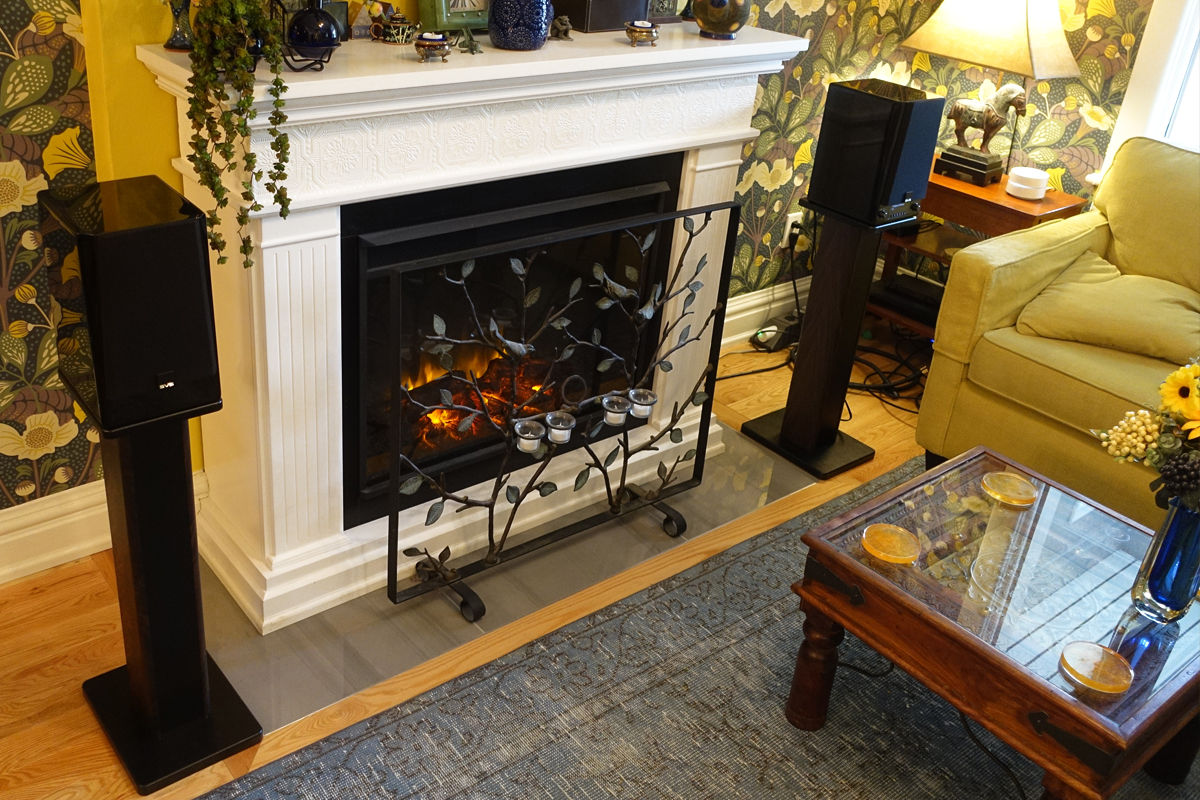
The Prime Wireless Pro could kick ass in my small home office, but how would it perform in a larger space? To find out, I moved the speakers downstairs to our living room, and placed them on either side of the electric fireplace, atop a pair of 28″ sand-filled MDF speaker stands I had purchased from Amazon.
Measuring 12′W × 10′D × 9′H, my living room isn’t large, but it opens through a large archway into a dining room that measures 11.5′W × 14′D, and through a door to an adjacent hallway. The Prime Pro system was able to fill this space with no distress, and only mild dynamic compression.
Playing Cassandra Wilson’s rendition of “Crazy He Calls Me” from her Billie Holiday tribute album Coming Forth by Day (24/44.1 FLAC, Legacy / Qobuz), the Prime Pro conveyed the thick, boozy atmosphere that producer and mixer Nick Launay (longtime producer for Nick Cave and the Bad Seeds) had intended. Within a cavernous acoustic, every instrument was locked in place: Robby Marshall’s ripe, fruity bass clarinet in the right rear; Jon Cowherd’s piano in the left front; Kevin Breit’s jangling electric guitar riffs in the center rear; and a string quartet at the very back.
I loved how the Prime Pro rendered Wilson’s sultry alto voice, right in the middle of the soundstage, a little above the speaker plane. I could visualize how she formed consonants, which sounded clear and distinct, but not at all hot or spitty.
The only flaw was Martyn P. Casey’s slow walking-bass lines on electric bass guitar, which sounded slightly boomy and indistinct. But as I’ve noted in many previous reviews, my living room has a couple of nasty standing waves, the worst being a 10dB peak around 62Hz.
Would adding a subwoofer improve the sound of Casey’s bass guitar? To find out, I connected my SVS 3000 Micro subwoofer ($899.99) to the right speaker’s sub output. The SVS sub works with a slick app that lets you adjust level, phase, and low-pass frequency, and implement up to three parametric EQ settings. With the aid of test tones, I used the SVS app to set level, low-pass frequency (100Hz), and three parametric EQ filters to compensate for my problematic room acoustics.
With the EQ’d sub in the mix, Casey’s electric bass notes had more texture and less boom. Instead of indistinct notes, I was now aware of Casey plucking the strings of his bass guitar. The overall presentation was a little more transparent, a little less congested (not that I was bothered by congestion before adding the sub).

To challenge the Prime Pro’s bass capabilities further, I disconnected the sub and cued up trombonist Marc Gaal’s arrangement for pipe organ and brass band of Jean-Baptiste Lully’s “Marche pour la cérémonie des Turcs” from Live from Vienna, by phil Blech Wien (which roughly translates to “Vienna Philharmonic Brass”) and organist Olivier Latry (24/96 FLAC, Deutsche Grammophon / Qobuz).
The track begins with a big drum roll, followed by a slow march rhythm, on timpani. I could clearly hear the mallets striking the drumheads and the resonance of the bodies of the drums—an auspicious beginning. Then the trombones (and later a tuba) start playing the main theme, accompanied by Latry playing quietly in the upper range of the Vienna Musikverein’s concert organ, while quiet timpani rolls continue that march rhythm. Through the little SVS speakers, I could hear these instruments reverberating through the Musikverein concert hall, so I had a clear sense of space.
But on Latry’s deep pedal notes, things fell apart a little. While those notes sounded impressively powerful, they were also drony and boomy. No doubt, the bass modes in my living room were a factor here.
In the middle of the piece, all the brass instruments join in, with more vigorous organ-playing by Latry. The Prime Pro threw a huge soundstage, extending a couple of feet above and behind the speaker plane, convincingly evoking the Musikverein’s legendary acoustics. Imaging specificity and front-to-back layering were excellent, with each of the brass instruments occupying a clearly defined place. The timbres of the instruments were totally convincing. The phil Blech Wien is known for its golden, burnished tone, and that came through beautifully here.
In the conclusion of the piece, the main theme is played more loudly, with chimes, bells, and other high-pitched percussion instruments joining in, adding an exotic Turkish flavor. Playing these big passages at suitable levels (I was getting peaks of 80dB), the sound became a tiny bit strident, dynamically compressed, and congested. That said, what this compact active speaker system did with this challenging recording was amazing.
Time to switch in the 3000 Micro. With the EQ’d sub filling in the bottom octaves, the timpani roll at the beginning had a bit more oomph. But the biggest difference was Latry’s pedal notes. There was still some boom, but it was markedly reduced. Not only were those notes deeper and more powerful, they had growl and texture, and less of an indistinct drone. The sound in the concluding section was more transparent, and less strident and congested.
How would these little speakers fare with a big action movie? To find out, I connected the primary speaker’s HDMI port to the HDMI ARC port on the One Connect breakout box for my 55″ Samsung Frame TV. The box is on a small rack on the right side of my room—I’d have been stumped if it was next to the left speaker.

I rented Top Gun: Maverick using the Apple TV app on my Apple TV 4K media adapter, which is connected to another HDMI port on the Frame TV’s breakout box. Big effects—Tomahawk missiles striking an enemy airstrip at the beginning of the climactic attack scene, the pounding drums of the soundtrack music—sounded very satisfying. But higher-frequency effects, like the screeching jet engines, were a tad harsh.
When I switched in the SVS subwoofer, the big bass drumbeats hit even harder, and double-bass notes had more texture. Explosions were deeper and more powerful, but also more detailed, so that I heard the initial attack of the explosion and then its reverberation, rather than one big boom. Of course, the explosions weren’t as visceral as they’d have been through a larger, more powerful setup; I heard them more than felt them. But given the sizes of the SVS sub and Prime Pro speakers, the sound was amazing. The higher frequencies of the screaming jet engines had less of a tearing quality. As good as the Prime Pro system was on its own, adding the SVS sub took its performance to another level.
Comparisons
Back upstairs in my home office, I compared the Prime Wireless Pro with the first-generation Prime Wireless and Q Acoustics’ M20 HD powered speakers ($599/system). I streamed music to the Prime Wireless using the Play-Fi app. For the M20 HD system, I connected Andover Audio’s tiny Songbird streamer ($99) to the primary speaker’s optical S/PDIF input and streamed music using the Songbird app. As in my first round of listening, I placed the speakers on IsoAcoustics ISO-130 desktop stands on the top shelf of my secretary desk.
Listening to “Silence Is the Question” from The Bad Plus Joshua Redman, Anderson’s double-bass plucks during the quiet intro had slightly better definition through the Qs compared to the SVS system, thanks to the adjustable room boundary settings of the Qs—I had selected the wall option. But the Prime Pro went deeper, maintaining robust output right down to the bottom notes. Through the Qs, Iverson’s piano had a touch more sparkle up top, but it had more heft and authority through the SVS system. King’s big snare beats sounded a little compressed on the M20 HD compared to the Prime Pro. And that big wall-of-sound passage at the end was more dynamically compressed on the Q Acoustics system. It was also more congested—kind of a mush—which made it hard to differentiate Iverson’s thunderous low-octave chords from Anderson’s double bass and King’s kickdrum. These elements were less mushed-together through the SVS system, so they were easier to pick out. But the Prime Pro was also a little harder-sounding than the M20 HD on this demanding passage.
Switching to the original Prime Wireless speakers, Anderson’s plucked double-bass notes at the beginning had a little less body and faded a bit as he approached the lowest notes of his instrument. But those low notes had better definition—the Prime Wireless Pro was a little boomy by comparison; likely a result of its more robust bass output combined with the placement near the wall. The lower notes of Iverson’s piano had more heft and authority through the Prime Pro, and his instrument even sounded bigger in the middle octaves. The big wall-of-sound section was a little harsher through the original Prime Wireless system, but a tad less congested.
Conclusion
In my review of the original Prime Wireless, I praised the system’s outstanding value. “Sonically, these little speakers punched well above their weight and price,” I wrote. I’d say the same about the Prime Wireless Pro. With its enhanced performance, added features, and improved software, the new model easily justifies the 50% price hike. I’m not the only one to think this. Earlier this year, the Prime Wireless Pro received a 2022–2023 EISA Award for Best Value Wireless Loudspeakers.
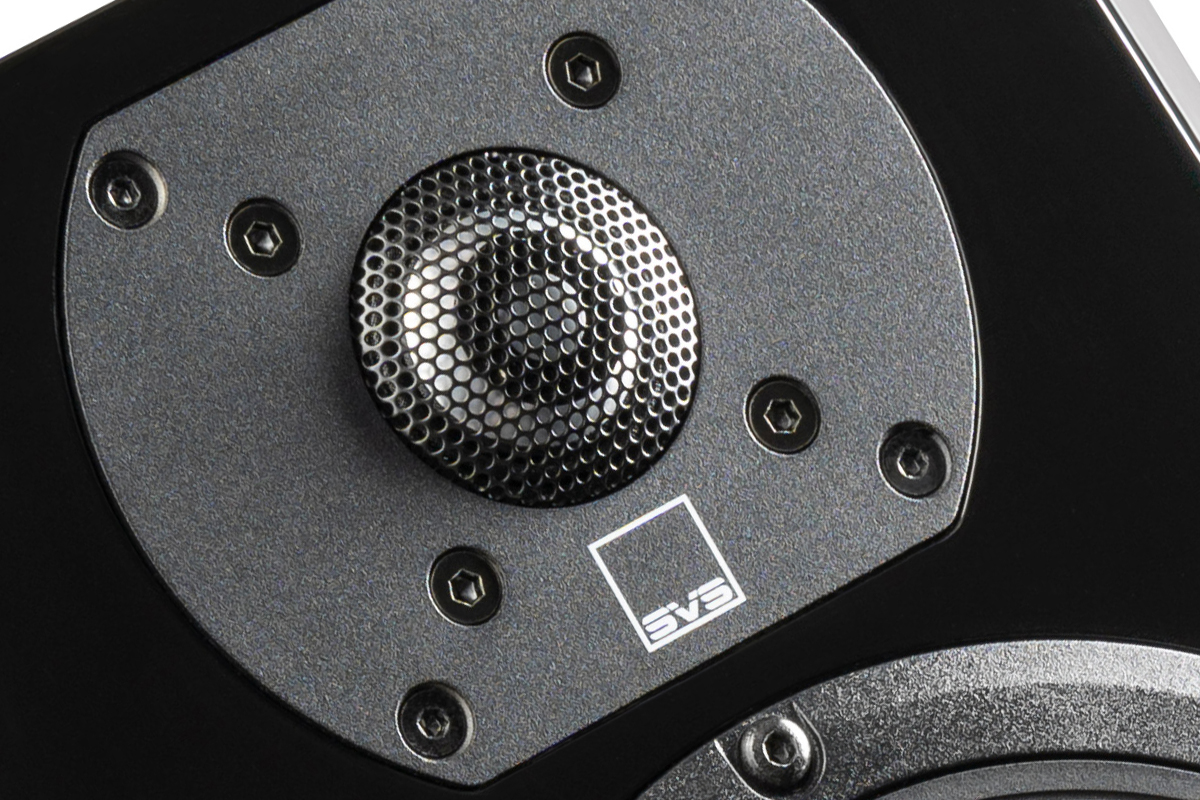
With its built-in network streamer, the Prime Wireless Pro is a self-contained music system. You can add other source components, but you don’t have to. I can imagine many use cases for this system. It’s a great choice for cost-conscious headphone listeners who want to discover the joys of listening out loud. As I experienced in my home office, it’s a great way to add two-channel hi-fi to a secondary room. And as I experienced in my living room, the Prime Pro is suitable for larger spaces as well, especially if you add a subwoofer.
On its own, the Prime Wireless Pro is a dynamite little two-channel system. Add SVS’s 3000 Micro subwoofer, and you’ve got a killer compact 2.1-channel setup.
. . . Gordon Brockhouse
Associated Equipment
- Active and powered speakers: SVS Prime Wireless, Q Acoustics M20 HD.
- Audio streamer: Andover Audio Songbird.
- Speaker stands: IsoAcoustics ISO-130, BQKOZFIN (27.5″).
- Subwoofer: SVS 3000 Micro.
- Display: Samsung UN55LS003 55″ UHD TV “The Frame.”
- Video streamer: Apple TV 4K.
- Control devices: Google Pixel 4a (5G) and Apple iPhone 8 smartphones.
- Network: Google Wifi four-node mesh network.
SVS Prime Wireless Pro Active Loudspeaker System
Price: $899.99.
Warranty: Two years, parts and labor.
SVS
260 Victoria Avenue
Youngstown, Ohio 44515
Phone: (877) 626-5623
Website: www.svsound.com



